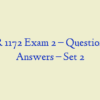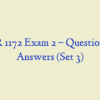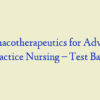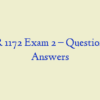Description
NURS 1172 Exam 3 – Nutrition Rasmussen
- A client calls into the nurse help line asking questions about his new diagnosis of a peptic ulcer. The client asks what might be possible causes of a peptic ulcer.
- A client is admitted with acute pancreatitis. What diet can the nurse expect to be initially prescribed?
- A client is admitted with urolithiasis (kidney stones). What prescription can the nurse expect from the health care provider?
- A client recently placed on lipid-lowering statins brings you her food log. Which of the following breakfasts would indicate a need to re-educate her?
- A client who has recently been placed on oral medication for his type 2 diabetes asks if he may continue to drink alcohol with his friends on the weekends. What is the nurse’s best response?
- A client with chronic kidney disease consumes an excessive amount of sodium. What symptoms will this client likely exhibit?
- At least twenty percent of women will experience a urinary tract infection (UTI) in their lifetime. Regular consumption of which food may help prevent the occurrence of a UTI?
- Carbohydrate counting is a useful tool in diabetes meal planning. How many grams of carbohydrate equals one carbohydrate serving?
- Diet for a patient on kidney dialysis is a vital aspect of maintaining biochemical control. What is one of the basic objectives in planning a diet for these patients?
- During a client’s recent colonoscopy, the health care provider found “pockets” in the colon and diagnosed diverticular disease. Based on the recent evidence, what dietary advice does the nurse give to the client?
- During an episode of acute exacerbation of inflammatory bowel disease, the client is unable to tolerate oral intake. What would be an appropriate form of nutrition?
- During your clinical rotation at the nursing home, your client is complaining of being constipated on a regular basis. You discuss with your client how to prevent constipation. What would you advise your client to avoid?
- Flatulence is the condition of having excessive stomach or intestinal gas. Which foods are generally responsible for excess gas production?
- Food intolerance can represent another type of reaction to certain foods. Select the correct answer that describes a common food intolerance listed below.
- How many grams of carbohydrate are covered by one unit of short acting insulin?
- How much monounsaturated fat intake is recommended by the therapeutic lifestyle changes (TLC) diet for lowering serum cholesterol for clients with elevated low-density lipoprotein (LDL) levels?
- Most oral medications are subject to the first-pass mechanism. Which food interferes with this mechanism resulting in increased serum drug levels?
- Older adults may experience harmful drug-nutrient interactions for many reasons. What is one of the most likely causes?
- Oliguria is a primary sign of acute renal failure. Select the correct definition of oliguria.
- Omega 3 fatty acids are recommended to be included in a heart healthy diet. What is a benefit of consuming omega 3 fatty acids?
- Studies indicate that water-soluble types of fiber have significant cholesterol lowering effect. What is an example of a food high in water-soluble fiber?
- The client presents to the emergency department complaining of an upset stomach with a burning sensation in the epigastric area. The symptoms have been happening off and on for the last few weeks especially when lying down to sleep. The client is exhibiting symptoms of which gastrointestinal problem?
- The development of cardivascular disease involves modifiable and non-modifiable risk factors. What is an example of a NON-modifiable risk factor?
- The nurse is educating a client on how to take aspirin (acetylsalicylic acid), a commonly used over the counter pain reliever. What comment would indicate that the client understands the instructions?
- The nurse is instructing a client on measures to take in the event of a severe allergic response to a peanut allergy. What medication should the client have immediately available?
- There are four classifications of diabetes. Which one is associated with obesity and insulin resistance?
- Viral hepatitis affects millions of people in the world. What is one of the main nutritional principles in planning for the nutritional needs of these patients?
- What are the two most common causes of end stage renal disease?
- What diet would the nurse expect to be prescribed for a patient with gallbladder disease?
- What imbalance can occur due to congestive heart failure?
- What is a common nutritional comorbidity with chronic obstructive pulmonary disease (COPD)
- What is the cause of essential hypertension?
- What is the most common cause of type 2 diabetes in children and adolescents?
- What is the most common component of kidney stones?
- What mineral will have improved absorption with a diet high in vitamin C?
- What symptom might be present in a client with undiagnosed type 2 diabetes?
- What term refers to the sudden shutdown of renal function following traumatic or metabolic injury?
- When following a gluten-free diet, what grains should be avoided?
- Which age group is most at risk for drug-nutrient interactions?
- Which blood test is used to evaluate long-term management and control in clients who have diabetes?
- Which is the primary feature of the Dietary Approaches to Stop Hypertension (DASH) eating plan?
- Which nutritent delays gastric emptying time creating more optimal saturation rates for drug absorption?
- Which term refers to elevated blood glucose?
- Which type of drug may result in a potassium deficiency?
- Why are dietary carbohydrates and fats important for clients with chronic renal failure?
- Your client has a peanut allergy. Which statement from the client indicates that your education has been effective?
- Your client has been diagnosed with celiac disease. The nutritionist was in and reviewed dietary needs for this diagnosis. The family asks which of the following items is ok for the client to eat.
- Your client has been diagnosed with congestive heart failure (CHF). Which of the following dietary suggestions is appropriate?
- Your client has been diagnosed with gastroesophageal reflux disease (GERD). You are reviewing the discharge instructions with the client and family. Which of the following statements verifies that the client understood his discharge instructions?
- Your client has had an elevated BP of 156/98 for the last few months. With reviewing his diet, which of the following items would you tell the client to limit in his diet?







